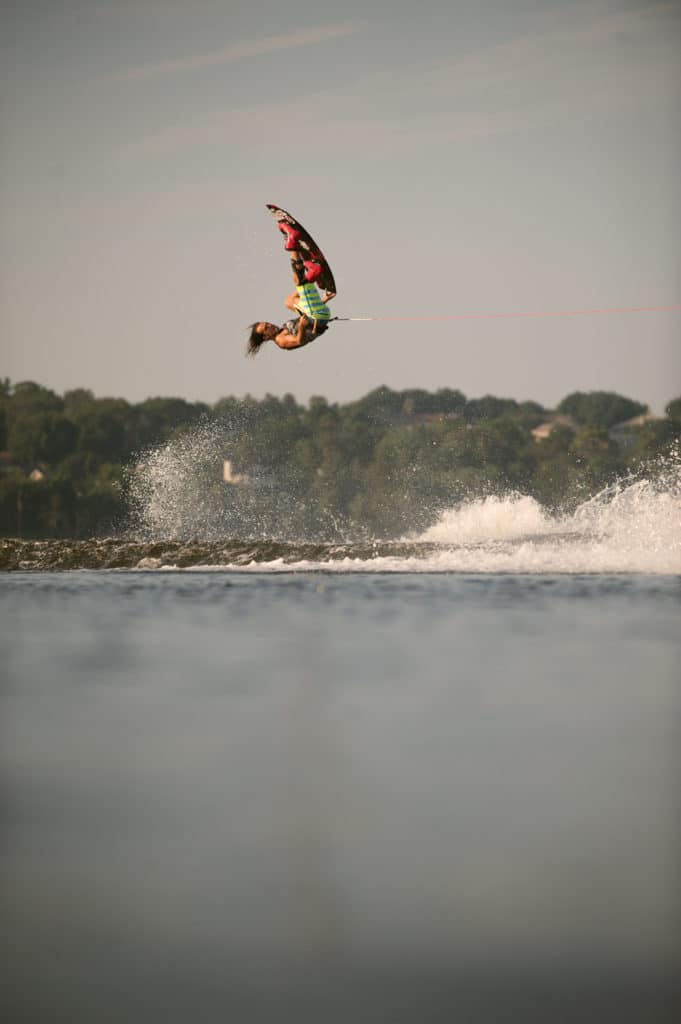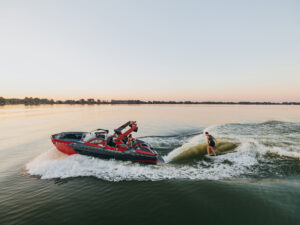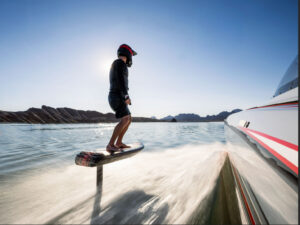Ever wonder how the pros make it look so easy? There’s a certain rhythm inherent in each trick that allows each trick to flow poetically. We break down the rhythm in three tricks with the help of a few riders who do them well. Check it out!
How To: Find the Rhythm in your Riding | Words: Brandon Judd | Photos: Jason Lee

Make It Look Easy
What does rhythm have to do with wakeboarding? More than you might think. In this instructional How To, we will walk you through three genres of rhythm using three specific tricks as examples to help you capture a better overall rhythmic flow in your riding.
The first and most basic aspect of rhythm is the pendulum swing that riders use to connect tricks back and forth, specifically targeting the edge out, the coast and the approach back into the wake. There is a lot of hidden momentum that can be taken advantage of. Ever wonder how pro riders make it look easy? Well, that’s because it is physically easy for them. Once you find this groove in your riding, wakeboarding becomes instantly less exhausting.
Second — and probably the most coveted — is the rhythm that a rider displays in the air. This is one of the more difficult aspects of rhythm to tackle when you are first learning because of the natural tendency to be impatient and initiate tricks too early. When properly utilized, this “air-time” rhythm can really accentuate a rider’s style. Timing the pop, grabs, shifties and stalled-out pause points mid-trick all are big factors in air-time rhythm. When this rhythm is properly integrated into your riding, the technical aspects of each trick will no longer inhibit your ability to add your own unique style to it.
The third portion of this instruction sits in a more technical arena. This specific type of rhythm is found within the motion of the trick itself, such as the pause point in a late heelside back roll to blind or a Pete Rose to name a few. Typically, more complex moves with line tension and blind landings will contain a certain rhythm. Once you can clearly recognize and anticipate this rhythm in each trick, your riding will become more consistent and further your overall progression.
Click here for MUTE ROLL TO REVERT——>
Use the Pendulum Swing for a Mute Roll to Revert

One thing to understand when connecting wake-to-wake tricks in a rhythmic fashion is recognizing where tricks begin and end. The answer may surprise you. Each trick begins near the trough of the wake prior to the edge out in preparation of your approach back into the wake. With that said, the end of each trick is not fully complete until you have finished traveling away from the wake after landing. This means that when you are connecting tricks back and forth, you are actually overlapping them.
Using Erik Ruck’s mute heelside back roll to revert as an example, you will need to use the forces around you to generate good momentum into the wake naturally without cranking in on a hard edge right off the bat. This pendulumlike motion allows you to travel at your fastest point with the most line tension at the wake — building your edge exponentially.
“A couple of things I think about while approaching the wake are: taking a long progressive edge but flattening off when you ride up the wake,” Ruck says. “As you ride up the wake, you want to make sure not to take off too early,” This swing into the wake has to be timed properly with your leg push and the initiation of your flip. Otherwise — especially when adding a mute grab — you will miss your pop and over-rotate your flip.
“You can’t be looking for your landing right off the bat.” Ruck Says. In order to keep the pendulum swing going in preparation for your next trick, you will need to land over your toes edging away from the wake. Landing on edge like this flirts with under rotation, which is why it is so important not to over cook the flip right off the wake. Ruck says that the reward for executing this trick properly is well worth it. “The longer you hold the grab, the better it feels … this is a great trick, and I will continue to do them until I can’t ride anymore!”
Click here for TOESIDE 360——>
Break Up a Toeside Frontside 360

Your time in the air is precious, and it is natural to not want to waste a moment of it. But this desire, though justified, may induce a tendency to cram the rotation into each trick as quickly as possible. As cliché as is sounds, each trick is really about the journey not the destination. Some tricks just plain don’t function properly if you cram the entire trick’s rotation into one third of your air time. Imagine a toeside frontside 360 where the entire 360 degrees of rotation are completed on the way up. That would cause the entire trick to change in function, make the blind landing nearly impossible and look bad in the process.
Keeping this in mind, we’ll take a look at a stylish toeside frontside 360 through the eyes of Jeff House. “When you’re trying toeside 360s, it’s very important to be patient — not only off the wake but with the spin as well,” Jeff says. Jeff points out that there are two different 180s that make up this toeside frontside 360: a toeside frontside 180 and a switch heelside backside 180. It is important to understand how these two 180s work in order to link them together in the air. Prior to trying this 360, you should be able to do the other two 180s at some level — for example, wake to wake, on one wake, or inside out at the least.
“If you’re comfortable doing toeside 180s — which you should be before trying three’s — then you know that if you hold on with two hands leaving the wake, the boat will automatically turn your hips around for the first 180,” Jeff says. “After the has turned you so you’re facing the boat, pause for a second, look at the boat, grab and poke, pick your nose, whatever you want — as long as you break up the two 180s … What really helped me was to think about doing 180 on the way up and the 180 on the way down.”
Click here for ROLL TO BLIND——>
Discover the Pause Point in a Roll to Blind

Now that you understand the basics of rhythm in broader terms, let’s get specific. In this section, we’ll look specifically at the rhythm and timing that exists in individual moves. This can get overwhelmingly complex if you are not very familiar with the motion of each trick. In order to mentally understand a trick and change it from a “flippy spinny thing” into a specific motion that you can recreate, you must spend some time on the trampoline recreating the feeling on the water.
With that understood, there is a certain, specific rhythm inherent in every complex move that you can feel your way through. We will use Trevor Hansen’s late heelside back roll to blind with a tail grab as an example. “Doing tricks like late roll to blind, backside 540s, and Petes are all about line tension,” Trevor says. “Having a consistent edge on these type of tricks makes it easier to get the same takeoff and have the same line tension every time.”
When these types of tricks are performed correctly, they will yield a small window of mild line tension — just enough to go to blind but not so much that it pulls you out of the trick. “You can find the pause in the trick, which tells you when to go to blind,” Trevor says. This pause point is crucial for consistency. If you were to map the trajectory of a roll to blind, its shape would resemble a breast cancer awareness ribbon rather than a circle as you might expect a flip to look. This pause point just after the peak of the trick is what allows for the backside 180 to flow naturally into the landing, much like the twist in the ribbon. You can expand this pause point by manipulating your line tension. “The edge will dictate your takeoff, and your takeoff will dictate your line tension, which will affect the timing of the pause to go to blind,” Trevor says.
Figuring out each trick’s timing is like learning a language; the more tricks you learn, the easier it will be for you to pick up on others. “It’s a fun thing to play with, and when you find the rhythm that works for your riding style, you start getting your tricks more consistent and all your tricks will feel easier and smoother,” Trevor says.







